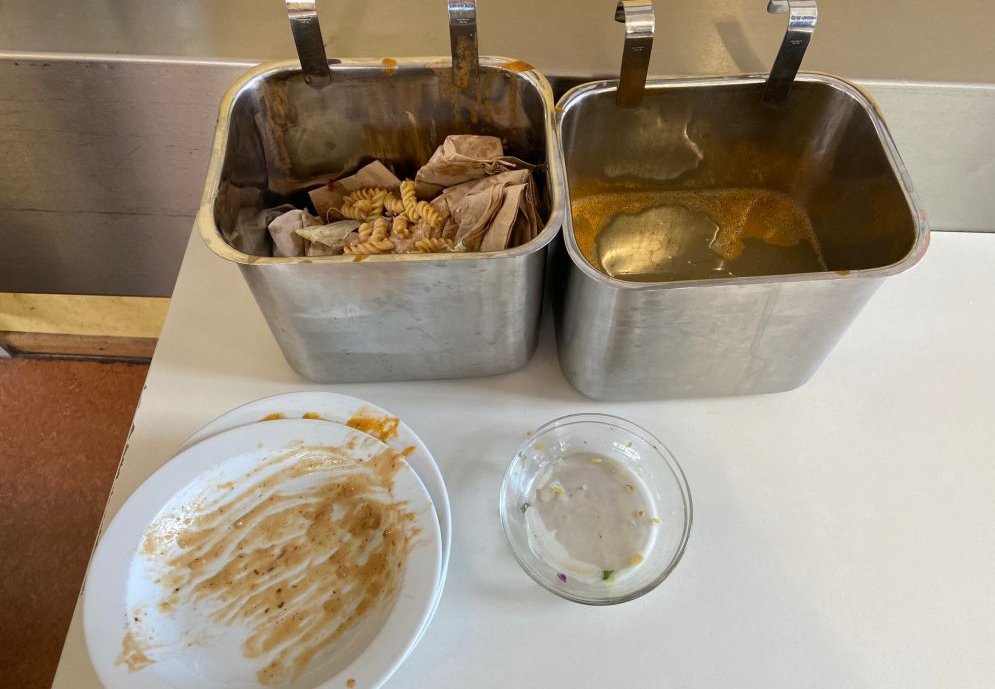

Me, you, us against food waste
Project summary
Become food waste detectives and measure food waste in the school canteen.
Learning outcome
The students...
- Reflect on their role as consumers
- Are aware of food waste
- Develop an appreciation for food
- Know the reasons for food waste
- Know ways to reduce food waste
Time required
18 teaching units over 5 days
Tools or equipment
- Scales (min. 40 kg maximum load)
- Container for measuring leftover plates
- Second container for other waste (napkins, bones, fruit bowl, etc.)
- Weighing protocol (canteen poster A1 and protocol template A4, see appendix)
- Pen, clipboard
- Bucket with water, soap and sponge
- Gloves, aprons, dough scraper
- Optional: cell phone or camera to photograph the full container
Activity description
Imagine that you are the detectives in your school canteen. Your task is to find out how much food ends up in the bin at lunchtime. To do this, you have to determine the amount of so-called plate leftovers. These are leftovers that are thrown away even though they would have been edible.
What materials and equipment do you need to measure and document plate waste? Create a checklist in the class discussion.
Key questions:
Now think about how you will carry out the measurement. Answer the following questions:
- How long should the measurement be carried out? (For representative results at least 5 consecutive days)
- Which location is suitable for a measuring station?
- When will the measurement take place?
- How does the measurement of plate residues work? Draw up a schedule of the process.
- What is measured? What data is read from the scales?
- What other information might be of interest?
- How is it recorded?
- What tasks are involved in the measurement? How many students do you need for this? Draw up a list of responsibilities and hang it up in the classroom.
- Who needs to be informed about your measurement campaign? How will these people be informed?
- Who is the contact person for questions?
Measurement:
Prepare for the measurement campaign together with your teachers. Get the necessary materials from your checklist and inform affected groups of people. Discuss the exact procedure for the measurement and which data will be entered in the log (see appendix). Use the poster “Measuring plate waste - this is how it works!” (see appendix) and hang it up in the canteen as a reminder.
Carry out the measurement on the agreed days. Each student takes on the previously defined role. Make sure that the leftovers are handled hygienically and that the measurements are documented accurately. You can also make a note of any anomalies, for example if there is a particularly large amount of a certain food left over.
Transfer your results from the log to the canteen poster to present them to the other students.
Discussion:
After each measurement: Present your observations to the class. Use the following questions as a guide:
- What food was served today?
- Were there any changes that were not on the menu?
- Which dishes or foods were left over particularly often or particularly rarely?
- What else did you notice?
- How many leftovers were there in total? How many leftovers were left per portion?
- What surprised you during the measurement? What surprised the other children about the results?
Reflection:
After the last measurement: Now reflect on your measurement results again. What did you particularly remember? What surprised you? On the board, collect possible reasons why food was left on the plates.
Get together in small groups. Collect ideas on what can be done to reduce the amount of leftovers on plates in future. Present your ideas to each other and discuss them in class. You can record the ideas that convince you all on a poster. Display all the posters you have created (planning, implementation, suggestions for improvement) in the school.
Optional:
Write a report for the school newspaper or the school website in which you report on your measurement campaign and the findings.
- Introduction: A short story and a picture can serve as an introduction (see appendix). The children should describe what they see in the picture and what the message of the photo could be. Together with the pupils, the topic of food waste and its problems are discussed (see poster in the appendix). The pupils think about where food is thrown away in their everyday lives and why this happens. They also learn about the dimensions of food waste and the term “avoidable food waste”. The teacher then encourages the children to think about their own school canteen. Together they decide to investigate this problem in more detail.
- Alternative: As an introduction, the video “What resources does our food use?” from the BMEL can also be shown. It uses the example of a breakfast table to show which resources are used for certain foods. This draws attention to the value of food and the problem of food waste.
Tips how to implement the topic to school curriculum
Expansion options
The results of the measurement campaign can be communicated to the entire school. Information material can be produced, reports written, or presentations prepared for this purpose. Based on the results of the measurement, measures can be developed and implemented to reduce plate waste. In this case, the measuring station should be repeated a few months later to check the effectiveness of the measures.
These resources were created based on the original by Landeszentrum Für Ernährung Baden-Würtemberg.
